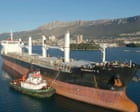
The Red Sea, a vital artery for global trade, has recently witnessed a resurgence in tensions, highlighting the fragile balance that governs this crucial waterway. On a day marred by violence, a Greek-owned cargo vessel, the Eternity C, fell victim to a devastating attack attributed to Yemen’s Houthi rebels. This incident, occurring after a period of relative calm, underscores the persistent challenges faced by maritime operations in the region.
The attack unfolded through the use of both drones and speedboats, exemplifying a sophisticated strategy employed by the Houthis. Tragically, it resulted in the loss of two seafarers’ lives, casting a somber shadow over the international maritime community. This deliberate act is reported to have followed the destruction of another vessel, reflecting a worrisome trend that has emerged in recent months.
Positioned along the coast of Yemen, the Red Sea is not only a passage of paramount importance for the transportation of oil and various commodities but also a symbol of economic interconnectivity across continents. Despite its status, recent violence has led to decreased traffic, primarily driven by security concerns following the systematic targeting of vessels by Houthi forces. These actions, justified by the rebels as a gesture of solidarity with Palestinians in Gaza, have amplified geopolitical tensions.
In an elaborate web of regional politics, the Iran-aligned Houthi militia has exerted pressure beyond Yemen’s borders, affecting maritime activities spanning far broader geographies. Their operations, symbolizing a larger regional conflict, potentially disrupt crucial supply chains and further exacerbate international lobbying for peace and stability.
The ramifications of these attacks extend beyond the immediate human and material losses. There are broader implications for international shipping firms and insurance companies, which must navigate an increasingly volatile landscape. Ships transiting these waters now undertake greater preventive measures, including rerouted paths and heightened onboard security protocols, to mitigate risks associated with such open-sea threats.
Historically, the Red Sea has served as a cultural and commercial bridge between nations. Recent events, however, challenge the security that has long underpinned this vital waterway. As the world grapples with evolving conflicts and unexpected disruptions, the call for diplomatic interventions grows more urgent. Dialogue and international cooperation are imperative to restore faith in the safety of these waters.
Efforts to minimize such incidents require multi-layered approaches, combining immediate security enhancements with long-term diplomatic resolutions. Leaders and stakeholders must reinvigorate talks aimed at establishing peace, not only within Yemen but also in the broader context involving its regional affiliations.
As vessels continue to brave the Red Sea’s uncertain waters, a harmonized global response will be essential. Prioritizing the safety and welfare of all involved is instrumental in ensuring that this channel continues to function as a safe passage, fostering economic prosperity and cross-cultural interactions.
The recent escalation serves as a reminder of the delicate peace that lines global trade routes and the pivotal role of ongoing dialogue and negotiation. By reaffirming commitments to international law and collective security, the maritime industry can hope to mitigate some of the emerging threats and instill confidence across its vast network.
As the world observes developments in the Red Sea, there remains room for measured optimism. Recognizing the resilience and dedication of those ensuring the flow of trade offers hope that the seas, a conduit for international collaboration, will once again be navigated with certainty and peace.
Source: {link}
